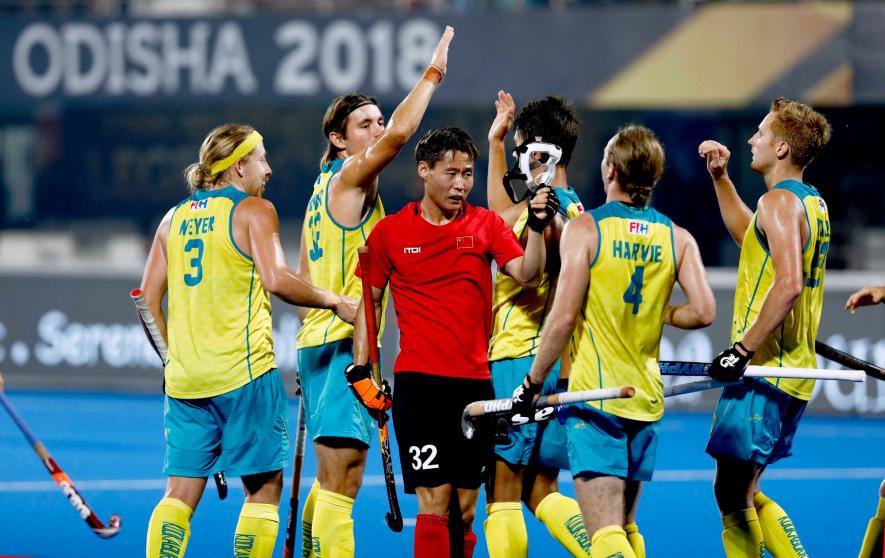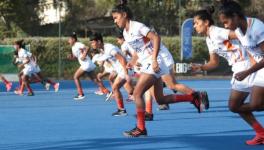Hockey 2024: FIH’s Global Expansion Dreams and the Turf Realities

In nations like China, hockey’s reach is extremely limited, despite the team qualifying for major events consistently.
It is a tribute to the indelible history of hockey, that even in a year littered with the Football World Cup, a Winter Olympics, the Commonwealth Games, the European Championships and the Asian Games, the FIH Men’s Hockey World Cup has been a grand, widely covered, engrossing affair.
Not to mention eminently saleable, another sporting commodity that has been lovingly lapped up by organisers, advocates and fans. But, in the days leading up to the showpiece game of the sports’ premier event, hockey wants more. It needs more. New subscribers on a new agenda for a new era.
‘Hockey 2024’, says the first slide of Mike Joyce’s presentation to the media. Joyce is the Executive Director of the International Hockey Federation’s (FIH) Hockey Foundation project. The Hockey Foundation, or, to give it its correct name, the Foundation for the Development and Promotion of Hockey, was constituted as the Swiss Foundation in 1985. The aim: supporting the FIH in enhancing the quality of hockey worldwide. In the past six years though, significant financial injections by the FIH had been a boost to its expansion efforts for the sport across the world. And now, this. A global effort to rebrand an old idea, an existing idea, a perennial idea, into a new box.
Also Read | The Alchemy of Desire: Belgium’s Decade Long Journey to the Pinnacle of Hockey
It is not hard to picture the marketing meeting on this one. What have we got then? What makes us different to any other sport? Goals? Technical brilliance? Forever sparkling gameplay? Err, no! But we do have beautiful blue pitches (if you have the green ones, never mind, they still work), a convoluted international calendar, startlingly poor high-ranked nations, and the ever-evolving gameplay rivalled only by FIFA’s annual video game offering.
According to the FIH, 136 nations, inclusive of 30 million people, play a form of hockey today. 106 of them regularly take part in international competition. According to the FIH’s numbers, 96% of these countries play the purest form of the sport (11-a-side, outdoors, surface variable). 63% also play the indoor version most popular in Europe. The numbers, by all accounts are impressive. Not football impressive, but definitely Olympic sport impressive.
What next then, you wonder? Movable goalposts? GPS enabled hockey sticks? Player cam footage for broadcast? Or something simpler: a new format for the game guaranteed to increase the sport’s visibility among the youth — Hockey 5s.
Also Read | Hockey India: Ruling With an Iron Fist
The press box is divided. The older crowd, the generation that has actually seen sub-continental hockey at its zenith, and the evolution of the sport from grass to turf, to blue turf, protest this dilution of the pure game. The current generation, the generation of the now, the speakers, the listeners and the observers of today, understand the need for this change. Progress for progress’ sake must be discouraged. But in the case of sport, progress for the sake of progress is progress itself.
“Football proved that what you need to sustain a sport is not tinkering with the rules and regulations,” says K Arumugham, a hockey journalist and historian. “You need to have more events, you take it to the people, you provide facilities for everyone to play. Hockey certainly lacks that but whatever changes they have done [with regard to the game] needs to come to an end now. Otherwise, it will soon be a situation where five-a-side hockey is there, but 11-a-side is also there. But the two cannot co-exist. One will be at the cost of the other. If 11-a-side hockey is finished, it will be a sad day for the sport.”
Arumugham’s fears are justified but are also somewhat premature. While five-a-side hockey has been adopted quickly across the world (59% of the countries affiliated to the FIH play Hockey 5s, according to Joyce), the original game has suffered not a bit. If anything, and if regular observers, including Joyce, are to be believed, Hockey 5s has injected pace and skill into the modern game in a way that pure rule changes could not.
Outside of Europe, 5s is in any case the entry level for the sport. Across India, rural hockey is rarely played as 11-a-side. It is a five-a-side game at that level. Despite the fears of it overtaking the pure game, the truth is that parallels to cricket’s T20 (which most seem to draw) are perhaps irrational.
Video | The Business End of the FIH Men's Hockey World Cup
The bigger concerns for hockey’s future revolve around expansion — to make sure every country across the globe plays the game competitively, and is affiliated to the FIH in a capacity that can financially, economically and strategically benefit all concerned. The immediate threat of being discarded from the Olympic schedule doesn’t exist, but, the fear of extinction does. Because the simple truth is this: Hockey’s patrons come from within. Outside the family of hockey, there is a fear that the game is dying out because of a lack of new ‘members’.
This fear is very real. While the idea of growing the game is noble, the truth is, even in places where the game was very prominent, there has been a decline. Pakistan for one. While the FIH is very quick to dismiss Pakistan’s problems as linked to ‘security’ and ‘political turmoil’ the scene repeats itself across the world.
India’s hockey playing population is limited to a few flourishing states. The team that took part in the FIH Men’s Hockey World Cup in Bhubaneswar consisted of seven players from the same academy (Surjeet Academy in Jalandhar), and nine from the same state — Punjab. Odisha, despite being hailed as the cradle for Indian hockey, has produced just two players for the National side in the past decade. Spain’s hockey keeps circling back to Terressa, Catalonia. China’s entire team comes from the single province of Inner Mongolia.
While the idea of inclusivity is admirable, the truth is, hockey is an exclusive sport. Most observers testify to the fact that in Europe the game is dominated by members of the middle and upper classes. The reason is simple. Accessibility to play areas defines a sport’s demography. The FIH may insist that the game can be played, and is played on different surfaces through the world, but right at the top, it is only played on artificial turf.
A young child learning hockey on mud or grass, with aspirations for Olympic gold will have to alter his/her game to suit the modern game soon. The talk of all inclusive surfaces is just that, talk. Admirable, but with not on real ground.
In fact, there is perhaps no need for hockey to expand unnecessarily at all. Instead, what may actually help aid the sport’s global image is a cleaning up of a really complex tournament calendar and a consistent application of it across the globe.
Video | Shooting Ace Gagan Narang on Mentoring, Competing, Olympic Dreams and Indian Hockey
Besides the continental championships, and the invitational tournaments, hockey’s structure over the past few years has included the Hockey World League, a tournament as difficult to understand as it is to play. Thankfully, the four-round, absurdly titled event is now extinct — replaced by the Pro League and the Hockey Series starting next year.
First let us deal with the Pro League. The competition hosts eight of the top ranked teams in the world. The ninth is Pakistan. The top four advance to the FIH Olympic Qualification round.
In the immediacy of their World Cup final loss to Belgium, even the Netherlands head coach Maximiliano Caldas sounded apprehensive about how the competition would work, considering the extensive club hockey system that already exists across Europe.
“Obviously the World League will be a huge addition to the calendar. It starts in a few weeks and the travel, and the games will have to be worked out without a marked effect on club hockey,” he says. “For us, most of our players come through the club system and obviously we cannot let that be affected.”
Shane MacLeod, Belgium’s coach put a positive spin on the situation, saying that his players pursue the profession with the ambition of constantly getting to play the game. The Pro League, he insists, will help the national team’s ambitions and form. Regardless, everyone will agree that coming so soon after the World Cup, will definitely dilute the initial days of the tournament.
Video | FIH Men's Hockey World Cup: For the Fans, By the Fans
Next, the Hockey World Series: It will be played through a maddeningly complex system of tiers, eventually giving six teams entry to the FIH Olympic Qualification round. Two of the highest placed nations who have not qualified for this through either of the competitions join in. The top six of the twelve teams taking part in the qualification round get berths for the Tokyo Games, joining the six who won their berths through the continental championships.
This is hugely problematic. The two competitions are essentially rivals — one hosting the cream of hockey; the other holding the batter that binds the sport together. For ease, we will call the batter India.
Consider the absurdity of this situation. India are the highest ranked side in the Hockey Series. They failed to make their way directly to the Olympics since then failed to win gold at the Asian Games, and settled for bronze. Even if they fail to make it through by finishing in the top two of their ‘tier’ (a fact that bears little thinking), they could still, realistically, get a shot at the Olympic qualification round thanks to the aforementioned rankings.
Realistically, once there, winning five games should see them through to Tokyo. In hockey’s quixotic world, the top teams of the world — make no mistake, India is one; the financial cash cow of a starved world — never miss the Olympics, and the expansion teams’ carrot dangles deliciously.
Get the latest reports & analysis with people's perspective on Protests, movements & deep analytical videos, discussions of the current affairs in your Telegram app. Subscribe to NewsClick's Telegram channel & get Real-Time updates on stories, as they get published on our website.
























